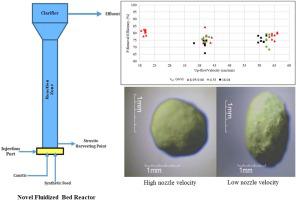Chemical Engineering and Processing: Process Intensification ( IF 4.3 ) Pub Date : 2020-09-23 , DOI: 10.1016/j.cep.2020.108155 Shayok Ghosh , Sergey Lobanov , Victor K. Lo

|
Recovering phosphorus (P) from wastewater as struvite has been investigated widely as this approach represents a solution to several wastewater-related problems. Some of the typical process units applied in the industry for struvite recovery from wastewater streams include fluidized bed reactors where individual struvite crystals are being agglomerated into spherical granules, or pellets. Various hydrodynamic parameters affect the extent of inter-particle collisions, the intensity of mixing, localized concentrations of ionic species, nature of eddies, etc. which determine the efficiency of the crystal agglomeration. This study evaluated the impact of three key hydrodynamic parameters (up-flow velocity, feed injection nozzle velocity, and nozzle configuration) on P-removal and recovery efficiencies in a newly designed novel fluidized bed reactor (FBR). Lowering up-flow velocities from 60 cm/min to 20 cm/min resulted in higher P-removal and recovery efficiency, whereas high up-flow velocities were favorable for the production of larger pellets and fines. Nevertheless, higher nozzle velocity (18.04 m/s) was responsible for improving P-recovery efficiencies. The nozzle velocity had a strong influence on the morphology of pellets and fines. High nozzle velocity contributed to the formation of the smooth-surfaced pellets and plate-shaped fines. Three different nozzle-configurations generating different flow patterns within the agglomeration zone were studied.
中文翻译:

研究流体动力学参数对流化床反应器中合成厌氧消化池上清液中磷回收的影响
作为鸟粪石从废水中回收磷(P)已被广泛研究,因为这种方法代表了一些与废水有关的问题的解决方案。工业上用于从废水中回收鸟粪石的一些典型工艺装置包括流化床反应器,其中单个鸟粪石晶体被团聚成球形颗粒或小球。各种流体动力学参数会影响粒子间碰撞的程度,混合强度,离子种类的局部浓度,涡流的性质等,这些因素决定了晶体团聚的效率。这项研究评估了三个关键流体动力学参数(上流速度,进料喷嘴速度,和喷嘴配置)在新设计的新型流化床反应器(FBR)中的P去除和回收效率。将上流速度从60 cm / min降低到20 cm / min导致较高的P去除和回收效率,而高上流速度则有利于生产较大的颗粒和细料。但是,较高的喷嘴速度(18.04 m / s)有助于提高P回收效率。喷嘴速度对颗粒和细粒的形态有很大的影响。高喷嘴速度有助于形成光滑表面的颗粒和板状细屑。研究了在团聚区内产生不同流型的三种不同喷嘴构造。而较高的上流速度有利于生产较大的颗粒和细粉。但是,较高的喷嘴速度(18.04 m / s)有助于提高P回收效率。喷嘴速度对颗粒和细粒的形态有很大的影响。高喷嘴速度有助于形成光滑表面的颗粒和板状细屑。研究了在团聚区内产生不同流型的三种不同喷嘴构造。而较高的上流速度有利于生产较大的颗粒和细粉。但是,较高的喷嘴速度(18.04 m / s)有助于提高P回收效率。喷嘴速度对颗粒和细粒的形态有很大的影响。高喷嘴速度有助于形成光滑表面的颗粒和板状细屑。研究了在团聚区内产生不同流型的三种不同喷嘴构造。高喷嘴速度有助于形成光滑表面的颗粒和板状细屑。研究了在团聚区内产生不同流型的三种不同喷嘴构造。高喷嘴速度有助于形成光滑表面的颗粒和板状细屑。研究了在团聚区内产生不同流型的三种不同喷嘴构造。


























 京公网安备 11010802027423号
京公网安备 11010802027423号